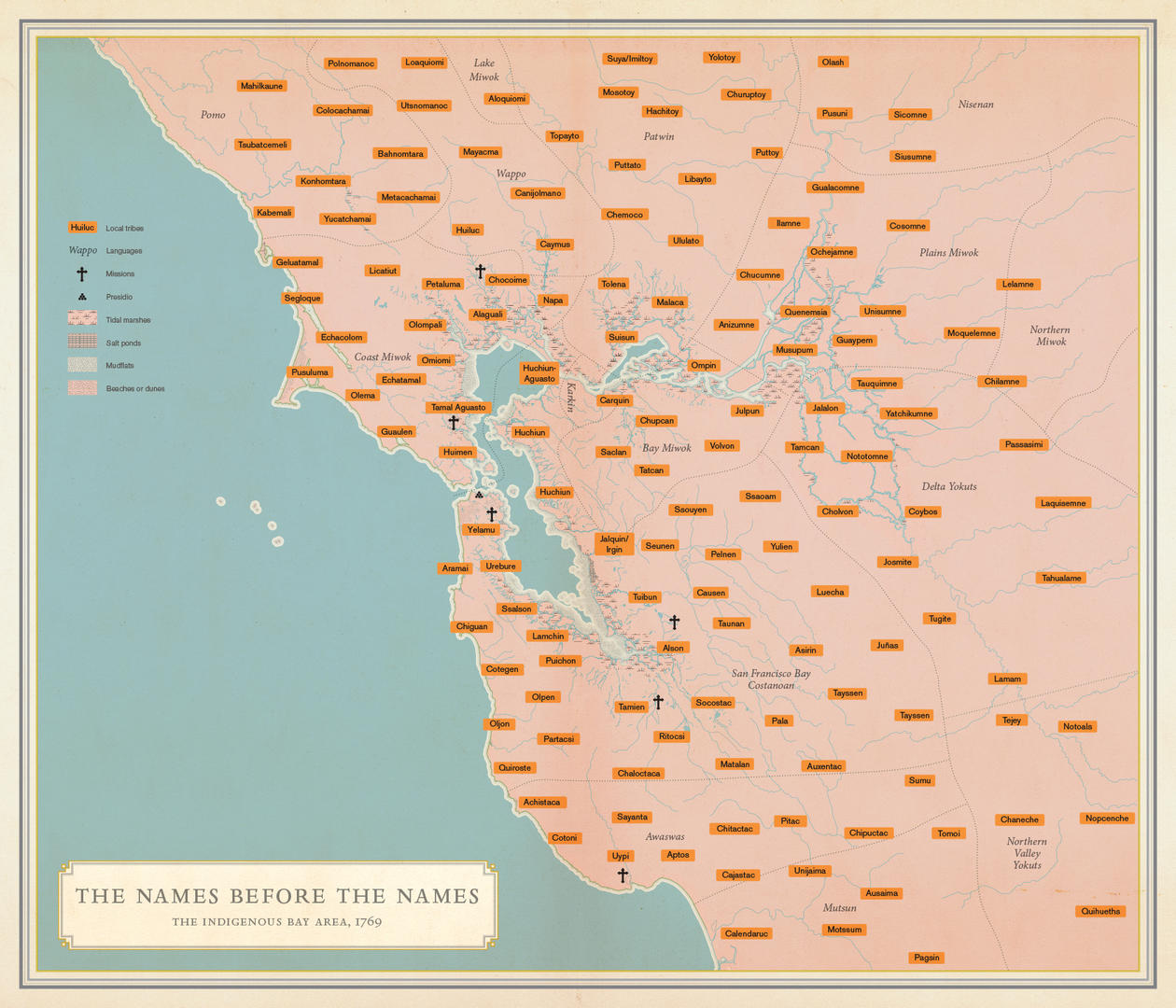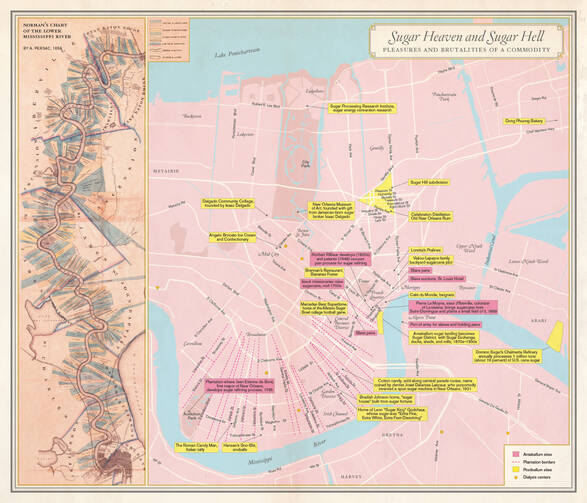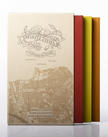What maps reveal about our surroundings (and ourselves)
When we were children, my brother and I would play with a set of miniature dinosaurs made of brightly colored rubber. The series of species—Triceratops, Brontosaurus, Stegosaurus, Pterodactyl, Tyrannosaurus Rex—repeated in green, blue, red and purple appealed to my sense of order. And their slight differences, which hinted at particular personalities, appealed to my imagination.
University of California Press
574p, $75
One quixotic toy-match made in heaven was the marriage of the dinosaurs and an oversized book of intricately illustrated mazes that I received for my sixth birthday. The mazes in this large book were gorgeous creations, illustrated by enchanted forests, desert cities, pirate ship holds. My brother and I would spread this book out and navigate the dinosaurs through the mazes, where they would fall into traps, get caught by ghosts or just get lost.
Solnit’s atlases are more like portraiture than the utilitarian GPS systems that populate our phones. These maps are intended for the relational kind of navigating.
But several designated mazes in the book were scenes in which we would have our dinosaurs make a home, divvying up cabin berths or tree houses. These particular mazes were landscapes not for passing through, but for remaining in.
As I was reading Rebecca Solnit’s trilogy of urban atlases, Infinite Cities, I was reminded of those childhood mazes. One of the mysteries that was clear to me as a child and is now hidden to me as an adult is how my brother and I decided which mazes were for traversing, and which ones were for inhabiting. When we flipped the page from the haunted forest to the desert city, how did my brother and I know that this map was not a map to have our dinosaurs travel through, but in which to remain?
All maps, not just those illustrated mazes, contain an inherent tension between going and staying. We consult maps in order to leave: which highways to merge onto, which exit to make, which turn to take. But we also make maps to know where we are: to get our bearings, to grow roots. Maps orient us, help us see where we are. A map is often a route to remaining.
All maps contain an inherent tension between going and staying. We consult maps in order to leave: which highways to merge onto, which exit to make, which turn to take. But we also make maps to know where we are.
Like language, cartography is a miracle that insists the unique slice of universe we view from the perspective of our own minds and hearts is—against all odds—expressible. Our memories and feelings are communicable, circumnavigable. I can tell you “I am sad,” and you can navigate with me the choppy waters of sorrow. I can promise “I love you,” and, suddenly, we have mapped a route to remaining.
“Each of us is an atlas of sorts,” Solnit writes. Solnit’s atlases are more like portraiture than the utilitarian GPS systems that populate our phones. These maps are intended for the relational kind of navigating. Cities, like humans, are porous, growing, evolving incarnate beings.
Although her massive, meandering atlases resist easy analysis and categorization, three key tensions provide the palette with which Solnit paints mosaic portraits of the United States’ three great urban souls: power, form and time. These tensions manifest themselves, respectively, as Technology versus Nature, Order pitted against Chaos and Past confronting Future.
Technology Versus Nature
Solnit’s atlases masterfully chart great leaps of technology that have built our contemporary cities: the great work in filling shorelines, of building bridges, of creating ingenious public transit. But they also display the cost. Solnit’s project responds to the subjugating gaze of the traditional atlas by portraying her city through populist, communitarian stories.
There are, tellingly, no real estate developers, politicians or business gurus contributing to these atlases. While the powerful’s voices are notably silent, their power continues to shape each city.
In the map “Makers and Breakers,” the works of Frederick Law Olmstead and Robert Moses are put on trial. The accompanying essay tallies Moses’ accomplishments: “Thirteen bridges, 416 miles of parkways, 658 playgrounds…and that’s a partial accounting.”
The essay notes the less-celebrated, more ambiguous accomplishments: among them the destruction of the Tremont neighborhood in the Bronx to make way for Moses’ Cross Bronx Expressway and the destruction of the middle-class black neighborhood of Carrville to make room for Olmstead’s Eastern Parkway in Brooklyn. “To make an omelet you need to break a few eggs,” Moses famously quipped.
The infrastructure and design of cities are built of human ingenuity. But Solnit’s atlases commemorate the intimate connections between the city and the natural environment from which they often seem divorced.
In the essay “400 Years and 500 Evictions,” Heather Smith bears witness to each broken “egg,” homes or livelihood destroyed for the sake of increasing the riches of the city’s elite. Consistently, the powerful forget that ordinary lives have a right to the city, that “living, working, cooking, voting, raising children, falling in love, and generally going about having a life (as interesting or dull as seems appropriate) are activities that confer a right to stay in place.”
The forces of power that are charted in these maps as ferrying oil, sugar or bananas through city streets forget that cities are not engines of profit, but ultimately communities of people.
In the San Francisco “City in a Cup of Coffee” map, Solnit demonstrates how nature’s own food chains and cycles intersect in even the most quotidian facets of urban life: “A cup of coffee is an ingathering of the world; the same cup of coffee, bought and drunk in a neighborhood café, is a sort of communion with the people and place around you.”
Solnit’s cup of coffee is a perfect metonymy for the city itself—an ingathering, a communion, a confluence of diverse rivers in one muddy delta.
The infrastructure and design of cities are built of human ingenuity. But Solnit’s atlases commemorate the intimate connections between the city and the natural environment from which they often seem divorced. Throughout her project, Solnit describes cities as “leaky” and “porous.” They are bulwarks of “manmade” space in the wild, but, as fancifully captured in the map “Wildlife,” the wild always creeps in.
Solnit’s atlases commemorate the intimate connections between the city and the natural environment from which they often seem divorced.
Order and Chaos
The artist Mierle Laderman Ukeles, profiled in the essay “Coming Clean” about New York City’s trash collection, is committed to art that renders “legible the land uses and invisible infrastructures on which our lives are built.” Solnit’s atlas project has the same goal at heart—to render legible the cities that are built of human design but also human spontaneity and happenstance.
Some of the most breathtaking, transporting maps are not geographically oriented at all. These are maps that chart populations. “People Who” charts ethnic and neighborhood stereotypes in New Orleans. A sultry map, “Hot and Steamy: Selling Seafood, Selling Sex” charts two of New Orleans’ main pastimes. “Snakes and Ladders” charts the chaos of the Katrina flooding, the violence, rumors and tragedies that ensued, and the kindness and altruism of neighbors.
One of the most basic distinctions in cartography is between land and water. And New Orleans, claims Solnit, defies that categorization. In that unfathomable city, water and land merge and submerge. The trickster coyote of the water table in “Moves, Remains: Hiding and Seeking the Dead” offers a grim comedy of errors—how does one bury a corpse when the water just below the topsoil buoys it to the top? The map reveals the contours of the not-so-underground New Orleans necropolis in grisly neons of Halloween green and purple.
“To understand a place is to know its past,” Solnit claims. Her maps are stunning excavations of lost cities underneath their current iterations.
In “Of Levees and Prisons,” the cartographer Shizue Seigel examines the largely ineffective means the city has used to attempt to pen up the river and the population it deems “undesirable.” This coercive and even violent implementation of order throws vulnerable communities into chaos. But the accompanying essay ends on a hopeful note: “The urge for freedom is too strong to be put down, no matter how high the walls.”

Solnit celebrates this uninhibited urban spirit in “Wildlife” and “Monarchs and Queens,” which document the queer spaces that offered liberation in San Francisco and New York City. Cities are the terrifying and tantalizing ids to the ego of public order.
The elaborate systems imposed by the powers that be—the school zoning system in “Public/Private: A Map of Childhoods,” the water system in “Water and Power: The Reach of the City,” or the structures for moving money in “Capital of Capital”—are all delicate crusts that eventually tend to crack.
In something as mundane as the trash system (“Trash in the City: Dumping on Staten Island and Beyond”) or as pernicious as the selling of bodies for sugar (“Sugar Heaven and Sugar Hell: Pleasures and Brutalities of a Commodity”), there lie seeds of revolt. “RIOT!: Periodic Eruptions in Volcanic New York” notes riots you’ve heard of (Stonewall, Occupy Wall Street) and riots you haven’t (the Rocking Chair Riot of 1901, the Brothel Riot of 1793).
Agents of disruption can also be peaceful: A gem of a map hidden at the back of the New York city atlas is a paean to the Quakers of Queens and the citizens of Flushing who drafted the 1657 Flushing Remonstrance to then-governor Peter Stuyvesant, admonishing him for ignoring the religious liberties of their fellow New Yorkers.
Past and Future
“To understand a place is to know its past,” Solnit claims. Her maps are stunning excavations of lost cities underneath their current iterations. “A City in Time: La Nouvelle-Orléans Over 300 Years” charts the slow but steady expansion of the city over swamplands. “Fillmore: Promenading the Boulevard of Gone,” celebrates the San Francisco drag lauded as the “Harlem of the West.”
In the accompanying essay, Solnit calls Fillmore a “core sample” that, like a sample bored from a tree trunk, informs observers about the creature’s health.
The past is found under city streets, but the future is its people. The New York atlas bursts with maps celebrating the immigrants who have carried New York into the future: “City of Walkers,” which reflects on the immigrants who “carry within them the maps of [their] wanderings” and add their maps, their stories, to the story of the city.
“Burning Down and Rising Up: the Bronx in the 1970s” maps the wasteland caused by landlords torching their buildings, and the resistance movement of youth that became hip-hop, a transfusion of new life into a decaying city.
Throughout the atlases, Solnit compares her cities to trees. Not only can you take a core sample from a city; they often grow in layers. Because of their rings, trees are physical incarnations of environmental memory.
Heather Smith’s brilliant essay, “Thirsts and Ghosts,” accompanies the map charting Manhattan’s imperial water supply system as a linguistic time travel device. Smith’s essay excavates the watery ghosts that haunt Manhattan, like Collect Pond, which used to sit under Manhattan’s jailhouse, the Tombs, and is now commemorated outside Manhattan Central Booking by a manicured park. A journalist opening up the trapdoor in the basement of a recording studio reveals Minetta Creek, still flowing near its eponymous West Village street.
One map charts the collision of past and future in the city. “Death and Beauty” marks each of the 99 murders in San Francisco in 2008, and a fair amount of the Monterey cypresses that populated the city circa 2009. The trees dotting the city remind us that this urban space had a greener, more natural past.
Throughout the atlases, Solnit compares her cities to trees. Not only can you take a core sample from a city; they often grow in layers. Because of their rings, trees are physical incarnations of environmental memory.
Cities can ravage the natural world around them, they can pillage and plunder natural resources, and they exploit—particularly the men and women within them. And yet cities are an intrinsically natural phenomenon. Like trees, cities hold in their physical bodies the precious memories of what humans have achieved; each layer is a precious tree ring recording the political, social and religious ecologies of its time.
Early environmental activists picked up the moniker “tree-huggers” as they literally held onto trees to prevent greed and profit from cutting them down. Clinging to the trees is a bid to save not just the tree, but the memory contained within it. It’s a plea to resist forgetting.
Cities can ravage the natural world around them, they can pillage and plunder natural resources, and they exploit—particularly the men and women within them.
Routes for Remaining
What to include in an atlas? Solnit wonders in each project. Despite a map’s claim to objectivity, it is always subjective, examining its subject through a particular lens of historical era, through a selective methodology.
An atlas, Solnit acknowledges, is written by the victors: by the colonists and conquerors, by those who are confident in their ability to travel and document that travel unimpeded. But no one can fully conquer a city. Solnit titles her atlases accordingly: “unfathomable,” “unstoppable,” “infinite.” The soul of a city is unconquerable.
Solnit’s atlases are maps for wandering—not out of the city, but down, through the rings of memory, through each layer of population, culture and history that has accreted on the soul of this urban being.
“If you walk a city, if you put in your miles and years with open heart and mind, the city will reveal itself to you. Maybe it won’t become yours, but you will become its,” Solnit writes. These atlases are apologies for going on pilgrimages and growing deep roots. These atlases are calls to become part of their stories. Looking at our maps and the cities around us, it becomes clear: Our private and public our relational and civic choices matter.
Cities are built of our choices: they make bridges, they raze neighborhoods, they build parks. So get out, walk the streets of whatever city you find yourself in, become part of its story. Find your own route for remaining.
This article also appeared in print, under the headline “Maps and Miracles ,” in the Spring Literary Review 2020, issue.











